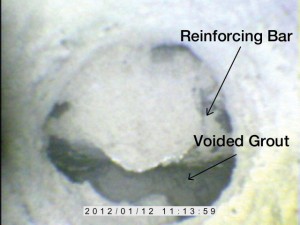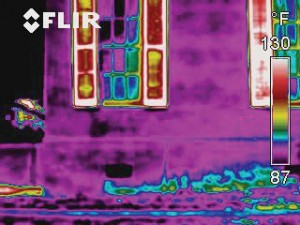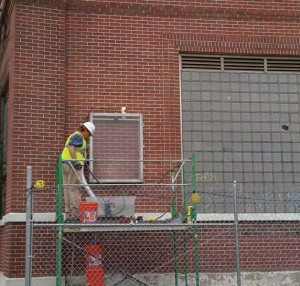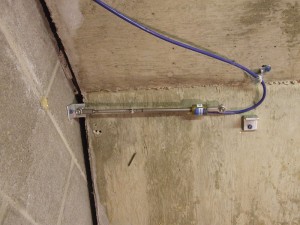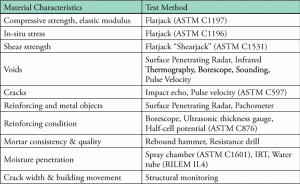Nondestructive and In -Situ Methods
Owners and designers may find themselves confronted with the task of deciding what to do with an existing masonry building, particularly if there will be a change of use or modifications to the structural system. Part of that decision should include determination of whether the structural system is adequate in its current condition for the building’s intended use, whether minor or extensive repair and retrofit measures are required, or whether the building has deteriorated to a state that it is beyond its usable life. Nondestructive and minimally invasive diagnostic techniques play a vital role in determining properties of existing masonry construction without causing excessive disturbance or disruption to the building fabric. This article discusses the different methods available for identifying masonry distress conditions and evaluating engineering properties such as strength and stiffness.
Material Properties
The masonry material properties needed by the engineer will ultimately depend on the role of masonry in the overall structural system, but may include compressive strength, shear strength, presence and extent of voids, existence and condition of reinforcing, and even moisture resistance. The use of destructive techniques may be undesirable due to the cost, damage and potential structural instability resulting from creating large openings or removal of several material samples. Fortunately, many nondestructive and in-situ methods exist, several of which have standardized procedures to determine necessary material properties without causing undue damage to the structure.
The keys to establishing a successful masonry testing program include determining which material properties are critical to the building’s intended use, as well as selecting an appropriate number of tests and test locations. For reinforced masonry, quantifying the presence of voids in grout, and location of reinforcing are likely to be some of the most important properties. For unreinforced masonry, particularly in historic construction, determination of compressive strength, elastic modulus, and shear strength is especially important in order to take advantage of these inherent material properties in design. In situations where variable construction or workmanship are encountered or suspected, additional testing can also help determine appropriate design values for different construction phases or parts of the building. For nonstructural masonry such as veneers, the focus will more likely be on connections to the structural system, moisture management, and energy issues rather than strength properties.
Nondestructive Techniques
Voids and Reinforcing
When investigating how solidly an existing masonry wall was built, simply tapping with a sounding hammer may be sufficient to determine if CMU cells are grouted or empty. For smaller voids and cracks in thicker, multi-wythe walls, more sophisticated techniques and equipment may be needed. Ultrasonic methods, such as pulse velocity which measures the transit time of stress waves between transducers, or impact-echo which measures the stress wave reflections from discontinuities in the structure, are both good tools for assessing the extent of internal cracks and voids. These types of irregularities can also be observed visually through the use of a fiber optic borescope inserted into an existing opening or small diameter drilled hole within a mortar joint (Figures 1 and 2). This method is also useful in cavity wall construction for observing veneer ties or excess mortar inside the wall cavity. Somewhat larger scale voids can be detected through the use of Surface Penetrating Radar (SPR) which locates material differences indicated by reflected microwave energy, and Infrared Thermography (IRT) which is capable of detecting temperature differences between the solid masonry materials and voided air spaces.
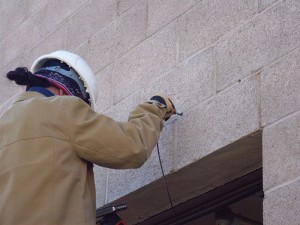
Figure 1: Using a fiber optic borescope inserted into a drilled hole in a mortar joint to view the inside of a concrete masonry lintel.
The existence of metal reinforcing bars, steel sections, or even pipes and conduit may be detected using SPR, relying on the highly reflective nature of metal objects to the transmitted radar energy. Other types of metal-detection devices such as a pachometer are also useful for locating veneer ties, joint reinforcing, and reinforcing bars that are located near the wall surface. Once the reinforcing is located, information about its size or quality may be desired. If a small opening exists or can be made to expose a portion of the metal reinforcing, its thickness can be measured using an ultrasonic thickness gauge without having to uncover the entire bar to take a physical measurement. The device transmits a sound signal into the exposed surface of the metal, and measures the amount of time required for the sound to travel through the material and its echo to reflect back to the surface. Half-cell testing measures the potential for corrosion of metal reinforcing by first connecting a wire from the device to a small exposed portion of reinforcing, and then surface measurements are made throughout the structure. This method has been used more commonly in reinforced concrete structures containing mats of reinforcing bars that are in contact or close proximity with one another, and thus has been able to provide good electrical continuity throughout the structure. Half-cell testing, however, has been used successfully to determine the potential for metal corrosion in reinforced masonry at locations that are electrically connected to the exposed bar, such as along a single vertical reinforced cell or along a bond beam.
Masonry Strength and Stiffness
An estimate of masonry compressive strength and elastic modulus is determined through the use of Flatjacks following the standard test method of ASTM C1197. Flatjacks are thin hydraulic bladders inserted into slots cut in masonry bed joints, and pressurized to perform an in-situ compressive strength test while monitoring the surface strain of the masonry between Flatjacks to generate a stress-strain curve (Figure 3). Although this method requires sawcutting two slots in the mortar joints to insert the Flatjacks, it is much less destructive than the removal of masonry prisms, which may be damaged during sampling or transport.
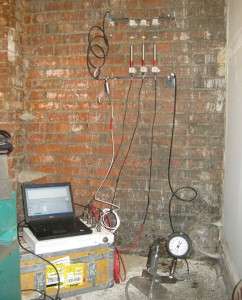
Figure 3: Masonry deformability test by the Flatjack method to estimate masonry compressive strength and elastic modulus. Both Flatjacks are pressurized while monitoring surface strain to generate an in-place stress-strain curve.
If the current stress state of the masonry is desired at a particular location, the single Flatjack method of ASTM C1196 provides a means to measure this property. First, the stress is relieved by cutting a horizontal slot in the bed joint, which also causes the masonry above to deform slightly. The Flatjack is then inserted and pressurized, and the pressure is measured as the masonry above is restored to its original position.
Similarly, masonry mortar joint shear strength may be measured using the standard test method of ASTM C1531, which utilizes a single specially sized Flatjack, also known as a “Shearjack,” to fit within a head joint, which is pressurized until it moves the adjacent brick unit sideways into the opposite, previously opened head joint.
Mortar Qualities
If there are concerns about the quality or uniformity of the mortar used in the existing construction, mortar quality and consistency throughout the building may be evaluated and compared using a rebound hammer, which measures the amount of rebound of a pendulum weight after striking the mortar surface, similar to the use of a Schmidt hammer device used for testing concrete surface hardness. In addition to surface hardness, knowledge of the mortar characteristics deeper inside the wall may be needed, such as in situations where past repairs or repointing have covered the original mortar with a different type of material. Resistance drilling techniques have been reported to produce good correlation with mortar compressive strength values, and only require small holes drilled in existing mortar joints.
Moisture Management
Moisture problems can be one of the biggest threats to both structural masonry and veneer systems. Although masonry is generally a very durable material, exposure to excessive amounts of moisture can lead to unsightly efflorescence, plant growth, and premature deterioration. In climates that produce freezing temperatures, especially those with many cycles of freezing and thawing, deterioration can occur more quickly if masonry remains saturated. Keep in mind, when investigating masonry moisture issues, that both the source of the moisture and the water penetration properties of the masonry are important. When weather conditions permit, IRT is useful for locating moisture paths and damp areas (Figure 4). Many types of electric capacitance-based moisture meters and resistance-based probes are available for detection of wet areas and are useful for tracing the moisture path to its source. The rate of moisture penetration through masonry walls is determined using the standard test method of ASTM C1601. The standard test chamber mounted to the masonry surface applies water and pressure, creating conditions that simulate wind-driven rain (Figure 5). The rate of water loss from the chamber into the masonry is measured, and is used to determine its water penetration resistance. Visual observations of the opposite wall face during the test can also give useful information about the path the moisture takes as it travels through the wall. A very fast and simple method for measuring water movement through a masonry surface is the water absorption tube test given by RILEM method II.4. RILEM (English translation from French: International Union of Laboratories and Experts in Construction Materials, Systems, and Structures) is an international technical organization which develops standards for testing materials and structures, similar to ASTM in the United States. Different tube sizes are available, but the configuration consists of a circular opening perpendicular to a vertical graduated tube. The opening is attached to the masonry surface and the graduated tube portion of the tube is filled with water, resulting in a pressure head being applied to the masonry surface. This type of testing is attractive because many tests can be performed quickly, and is useful for getting an impression of masonry absorption, or for comparing water repellent treatments.
Quality & Performance
Quality Control
A successful construction or repair project depends on the quality of work performed being as good as it was designed and specified to be. Nondestructive methods such as SPR and IRT are especially useful to determine the effectiveness of repairs such as rebuilding or injection, especially when a “before and after” comparison can be made with the results. Metal detection methods are also helpful for confirming the placement of retrofit anchors or veneer ties without visual observation. The costs associated with these methods are likely to be lower than providing full-time inspections, or opening completed repairs for observation and repeating the repair work.
Structural Monitoring
A good monitoring program can provide peace of mind before, during, and after repairs are conducted. Before deciding which repairs are necessary, structural monitoring can help determine if cracks are active or dormant, and if the building is moving, whether the movement is due to natural weather cycles or something more serious. Monitoring systems that operate on vibrating wire technology feature a central datalogger connected to sensors that are capable of measuring crack width, tilt angle, surface strain, and temperature. The system itself requires only a low power input, so extended longevity is possible with little maintenance. These monitoring systems can be installed using adhesives or small anchors, so the impact to the structure is minimal (Figure 6). During construction, monitoring is useful to determine if the ongoing activity is causing additional building distress or movement. The activity does not necessarily need to originate from your site to affect your structure, either. An adjacent excavation or heavy equipment can affect your building as well.
After repairs, strengthening, or stabilization work have been completed, a long term structural monitoring program will result in valuable data that will aid in diagnosing future distress, aid in detecting potential problems before they become serious and more expensive to fix and, finally, ease concerns about long term structural performance.
Conclusions
A variety of nondestructive and in-situ methods exist to determine material properties and to diagnose problems in existing masonry structures without the need for sample removal. The information gained from a testing program that is well-planned and performed correctly, with results interpreted by experienced professionals, can reduce costly repairs to the concentrated areas where they are needed, and can provide design engineers with confidence about the materials they are working with on any given project.▪
Andrew Geister, P.E. has been involved in masonry nondestructive, in-situ, and laboratory material testing while working for Atkinson-Noland & Associates, Inc. in Boulder, Colorado. He is also a member of The Masonry Society’s Existing Masonry Committee and Design Practices Committee. Andrew can be reached at ageister@ana-usa.com.
